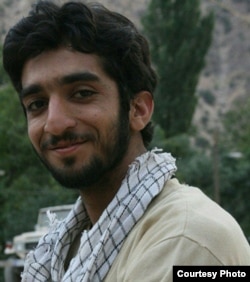Several Islamic Republic officials, including Qods Force commander, Major General Qassem Soleimani have vowed to take revenge for the beheading of an Iranian serviceman by Islamic State group in Syria.
A member of the Islamic Revolution Guards Corps, IRGC, Mohsen Hojaji was captured by ISIS on Monday, August 7 and reportedly was decapitated two days later, on Wednesday.
Mohsen Hojaji has been introduced as an Iranian “military adviser” taken “hostage” by the Islamic republic media.
In a message quoted by Fars, a news website run by the IRGC, Soleimani pledged to revenge the “savage attack through eradicating Wahhabism and Takfiris from the Islamic world”.
These crimes committed “by terrorists”, Soleimani maintained, “made us more resolved and determined to clean every place of the Islamic lands from their evil existence”.
In a separate message, Commander of the IRGC Ground Force Brigadier General Mohammad Pakpour, echoed Soleimani’s vow to revenge and said, “ISIS will be punished for its heinous actions”.
Mohsen Hojaji was a member of the IRGC’s “Najaf Ashraf 8th Division” and from city of Najafabad in Isfahan province. Iranian media in recent days have published photos depicting him at what is called “Jihad camps”.
Hojaji was captured during a clash at al-Tanf area, near Syria-Iraq-Jordan border, it has been reported.
IS released a video on Wednesday, August 9, showing the decapitation of Hojaji. The video was widely distributed on social media.
According to local news, an IRGC colonel, Morteza Hossein Pour Shalmani was also killed in Syria at the same time Hojaji was captured.
Furthermore, three more IRGC members, Mohammad Tajbakhsh from Khuzestan, Ali Azimi from Kerman and Mohammad Alipour from Isfahan were also killed in Syria, in recent days.
Meanwhile, IS has published a video threatening new attacks in the Iranian capital Tehran, calling on young Iranians to rise up and launch jihad in their homeland.
A man wearing a black ski mask and holding an AK-47, seated alongside two others, made the threat in a video bearing the ISIS’s Amaq news agency logo and showing footage of two attacks in Tehran in June claimed by the militant group Reuters reported.
“The same way we are cutting the necks of your dogs in Iraq and Syria we will cut your necks in the center of Tehran,” the man said in Persian (Farsi).
The group killed at least 18 and left more than fifty people wounded in attacks on parliament in Tehran and the mausoleum of the founder of the Islamic republic, Ayatollah Khomeini on June 7.
Eleven days after the twin attacks in Tehran, the IRGC fired six mid-range ballistic missiles, within a range of 650 to 700 km, at ISIS bases in Syria's eastern region of Deir ez-Zor on June 18.
The Islamic Republic of Iran’s officials praised the IRGC’s missile attacks as a great success. But they issued different IS casualty figures; ranging from 85 to 170. These numbers have not been confirmed by independent sources.
Praising “this great success” Deputy Chief of Staff of the Iranian Armed Forces, Brigadier General Massoud Jazayeri warned, “If the Americans and the Zionists (Israel) do not change their manners, we will take more drastic steps-hereby announcing that we have the means of punishment at our disposal.”
However, Israeli military chief Gadi Eisenkot said Tehran was lying about the strike: “Their achievement was less than what was reported in the media. The strike manifested something, but it was far from a direct hit or what they have said,” Eisenkot told the Herzliya policy conference on Tuesday.
IS, an extremist Sunni group (called as Takfiri or heretic by Tehran) which has sought to establish a caliphate in the Middle East but is now under pressure from national armies and international groups in Syria and Iraq, sees the Islamic Republic of Iran, which is predominantly Shi’ite, as one of its biggest enemies in the region.







